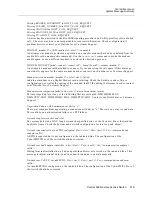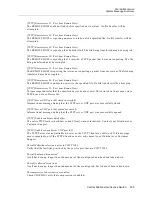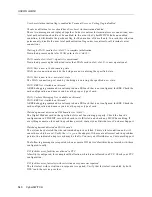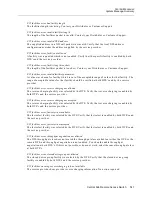
USER’S GUIDE
528 CyberSWITCH
Semipermanent. Device "x" disconnected by admin
The administrator has issued a
disc device <device name>
command. Therefore, the system
will not attempt to call the indicated device again. Issuing the
call device <device name>
command will make device “x” semipermanent again.
Semipermanent. Device "x" has a smaller Initial Data Rate than Base Data Rate. No connection made.
The semipermanent feature will make enough calls to meet but not exceed the device’s Initial Data
Rate. In this case, the Base Data Rate (normally 56 or 64 Kbps) is larger than the device’s Initial Data
Rate. The semipermanent feature cannot make any calls, or it will exceed the Initial Data Rate.
Reconfigure your data rates.
Semipermanent. Device "x" has had "y" bandwidth drops within "z" seconds. This device is considered to
have failed remote authentication.
Because the local system cannot always be aware of remote authentication failures, and because
there is no way to recognize remote authentication failures in the system once the remote end is
authenticated, the semipermanent feature will try to determine them by detecting excessive remote
bandwidth drops. The remote device must drop a call 10 times within a 10 minute period to trigger
this event.
Will try again in "w" minutes.
This will be displayed directly beneath the above message if a Session Interval is
configured for the device.
Semipermanent. Device "x" reconnected by admin.
The administrator has issued the
call device <device name>
command after issuing the
disc device <device name>
command. This restarts the semipermanent feature for the
indicated device.
Severe congestion CLLM received for DLCI <dlci index>
A CLLM message was received indicating severe congestion may be expected on the PVC
associated with the indicated DLCI.
Signal for unknown CallCmd task: <task Id>
Contact your Distributor or Customer Support.
SIG_notify Failure. Called Session is not Active.
An error has been detected in the R2 signaling procedure, and will typically result in a failed call.
The error was due to unrecognizable or incorrect information. If problem persists, contact your
Distributor or Customer Support.
<slot # , port # > Cfg Error
Line vs. adapter configuration error. A line is configured for port <port # > that does not exist on
the adapter in slot <slot # >.
















































